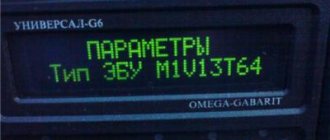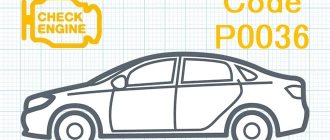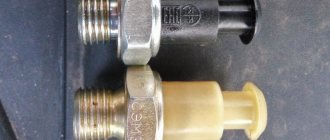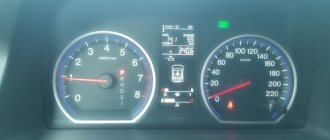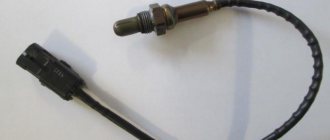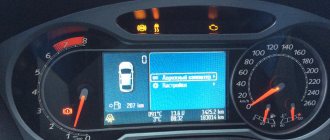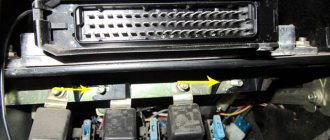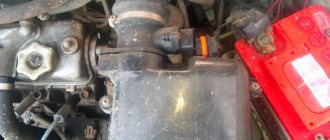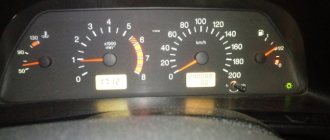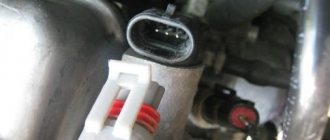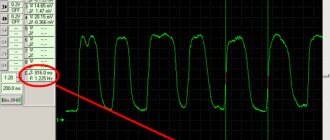What does code P0130 mean?
This Diagnostic Trouble Code (DTC) is a generic transmission code. This means that it applies to all OBD-II equipped vehicles. Although the general and specific repair steps may vary depending on the make/model.
Bank 1 is always the block that contains cylinder #1. Sensor 1 is always the upper DC, located in front of the catalyst.
The oxygen sensor (OS) produces a voltage based on the oxygen content in the exhaust. The voltage varies between 0.1 and 0.9 volts. 0.1 means a lean mixture, 0.9 means a rich mixture.
The engine control unit (ECU) constantly monitors this voltage in a closed circuit. This is necessary to determine how much fuel to inject. If the ECU determines that the DC voltage has been too low (less than 0.4 volts) for too long (more than 20 seconds - time varies by model), code P0130 is set.
What repairs can fix the P0130 code?
To resolve P0130, you may need to:
- Connecting the OBD-II scanner to the vehicle diagnostic connector
- Checking for an Error Code
- Analysis of data stored in the vehicle's ECM memory
- Clearing error codes from computer memory
- Test drive your vehicle to see if P0130 appears again
- Check and, if necessary, repair or replace electrical wires or oxygen sensor connector
- Checking and, if necessary, replacing the oxygen sensor
- Check and, if necessary, replace the engine control module (ECM)
Troubleshooting
Using a scan tool or adapter, determine whether sensor 1 in cylinder block 1 is switching properly. It should switch between lean and rich conditions quickly, evenly.
Step 1
If so, the fault is probably intermittent. You should check the wiring for visible damage. Then wiggle the connector and wiring while observing the oxygen sensor voltage. If the signal changes, secure the appropriate part of the wiring harness to the location where the problem occurs.
Step 2
If the DC is not shifting properly, try to determine whether the sensor is showing the exhaust correctly or not. This can be done by briefly removing the vacuum supply from the fuel pressure regulator. The oxygen sensor should show a rich mixture in response to the addition of additional fuel.
Restore the fuel regulator to its previous condition. Then create a lean condition by disconnecting the vacuum line from the intake manifold. The oxygen sensor should show a lean mixture in response to the increase in air.
If the sensor is working properly, there may be nothing wrong with it, but the problem could be holes in the exhaust or an unaccounted for vacuum leak in the engine.
Unmeasured engine air leaks are almost always accompanied by lean error codes.
If there are holes in the exhaust, it is possible that the O2 sensor is misreading the exhaust due to excess oxygen flowing through them.
Step 3
Perhaps the DC simply does not switch or works slowly and sluggishly. Disconnect the sensor connector. Using a multimeter, make sure it is receiving 5 volts of reference voltage.
Next, check for 12 volts in the oxygen sensor heater circuit. Also check the continuity of the grounding circuit.
Error p0130: oxygen sensor circuit low voltage
Modern car owners independently diagnose certain errors in the car's ECU. The scanner allows you to quickly and accurately identify any problems in systems and indicate further actions to eliminate them.
IMPORTANT! When checking independently with an auto scanner, a driver who encounters error p0130 does not have to contact the service center, but can fix the problem with his own hands. In the overwhelming majority of cases, the causes of this error do not require professional instruments and specialized equipment for repair.
What a mistake
Error code p0130, detected by the auto scanner, indicates low voltage in the lambda probe circuit (or oxygen sensor mounted upstream of the catalyst). Almost all modern car models are equipped with oxygen sensors in the exhaust system, which can significantly reduce toxic emissions and make the engine more productive.
Error p0130 can be detected both when the sensor itself breaks down and when there is a short circuit in its wiring.
Signs of a malfunction: how the car behaves with error p0130
The driver can identify faults in the lambda probe voltage circuit without using a scanner. After all, the error p0130 that appears will immediately affect the operation of the power unit, while the maximum driving inconvenience will be noticeable at increased crankshaft speeds.
Error p0130 is also determined by the following symptoms:
Often, all of the above signs of voltage loss in the oxygen sensor circuit do not appear immediately, but after several days of operating the car with error p0130.
Further operation of the vehicle is possible, but it is worth considering that ignoring the error significantly increases the risk of breakdowns of expensive engine components. Malfunctions in the oxygen sensor voltage circuit directly affect the quality of exhaust gases and the productivity of the power unit.
What to do if error P0130 occurs
As you can understand from the description of the problem, there are not many factors that lead to error P0130. Accordingly, the driver or technician can get rid of the malfunction by performing the following algorithm of actions to determine the cause of the problem and eliminate it:
The first step is to check the wires that supply the first lambda probe (installed before the catalyst);- If power is supplied through the wires, carefully inspect the oxygen sensor connector for corrosion, damage, carbon deposits, contamination and other defects;
- Next, it is recommended to check the voltage between the lambda probe signal wire and ground. To do this, you need to connect the voltmeter probes to them. If the oxygen sensor is working properly, its voltage will be around 0.45 Volts (if the voltmeter shows a different number, it is recommended to check the voltage value for your specific car model, as it may differ);
- It is also recommended to use an ohmmeter to check the resistance of the oxygen sensor heater (two white wires). The resistance value will vary from 2 to 10 ohms, depending on the car model. The exact value can be found in the documentation for the sensor;
- If the problem is not related to the wiring and oxygen sensor, you need to check the mass air flow sensor and the tightness of the exhaust manifold; the gaskets may need to be replaced. Be sure to diagnose the presence of suction in the circuit after the flow meter.
Depending on what problem was identified during the diagnosis, it is necessary to carry out the appropriate repair work:
If there are problems with the wiring: find the break point and fix the problem;- If there is a crack in the exhaust manifold: perform the necessary work to create a seal (welding or replacing the faulty element);
- If the sensor is broken: replace the sensor. It is important to note here that you should not skimp on the oxygen sensor and purchase a cheap Chinese analogue of the original lambda probe, since problems often arise with them. It is also not recommended to install the so-called “fake” and flash the ECU. It may get rid of the P0130 code, but other problems will arise later.
After completing the necessary steps to eliminate the P0130 error, you should let the engine run for some time in various modes (especially those in which the Check Engine light came on) and reset the error.
Most often, error P0130 is diagnosed on Opel, Kia, Hyundai, Subaru and Ford vehicles.
( 436 votes, average: 4.55 out of 5)
Error P0327 - low signal from the knock sensor
Error P0120 – throttle position sensor malfunction
Related Posts
Causes
Error code p0103 appears in the memory of the car's electronic control unit only after the oxygen sensor has not generated any signals for 60 seconds or more. Thus, if there is no signal from the lambda probe for 1 minute (or it is erroneous, fragmentary and late), then error data p0130 is entered into the memory of the on-board computer.
After 10 seconds, the yellow “Check Engine” indicator lights up on the instrument panel in the cabin - the first sign of a malfunction in the vehicle’s systems. It is this error icon that becomes the first sign for the driver that there is a malfunction or breakdown in the system.
The reasons for the appearance of error p0130 can be many factors:
In some cases, along with error p0130, error p0134 may be recorded. Two codes detected together indicate a failure of the lambda probe. That is, there are no other reasons for the error to appear.
Rebooting the client
First of all, try to restart the client; it may have been loaded with errors. To do this, go to the Steam menu and click on Exit.
After closing, open the Task Manager by pressing Ctrl + Shift + Esc and go to the Processes tab. Check to see if there are any Steam processes running. If you find one of its processes, wait for it to complete. After this, start the client and repeat the action that caused the connection to fail with code 130.
How to fix error p0130 yourself
Before eliminating the error, you need to understand the exact cause of its occurrence - the sensor or voltage circuit. You can identify the source and take the necessary measures based on the given algorithm of actions:
Accordingly, after identifying the cause of the malfunction, you need to select an appropriate plan to eliminate error p0130:
After completing all the steps, you will need to reset the error - for this you can use the elm327 usb adapter. After the reset, you need to start the engine and let it run in different modes for 10-15 minutes. The "Check Engine" icon should go out.
When replacing the lambda probe yourself, it is not recommended to purchase an affordable Chinese analogue of the device. Saving in this matter is not appropriate, since problems will constantly arise with the sensor. The cost of a new lambda probe, depending on the model and year of manufacture of the car, can range from $100. It is also not recommended to install a “fake” and flash the ECU to reset errors. In this way, you can eliminate errors from the memory of the on-board computer, but do not eliminate their presence in the system.
It is worth noting that most often error code p0130 is diagnosed on Opel, Kia, Hyundai, Subaru and Ford cars. This is due to the design features of cars of these brands.
content .. 147 148 149 150 ..Lada Priora (2013+). Cause of error P0130
P0130 - Oxygen sensor error
Trouble code P0130 appears in the engine management system when the oxygen sensor voltage is outside the specified range. This error code can be caused by an open or short circuit in the oxygen sensor circuit, wear of the sensor, as well as due to the mixture of oxygen and fuel being too lean or rich, fuel leakage, depressurization of the exhaust system, etc.
Causes of error (code) P0130:
The error occurs when the oxygen sensor circuit voltage is low (bank 1, sensor 1). To eliminate this error, you need to change the first lambda probe, provided that there are no problems with the exhaust system.
Diagnostics when error code P0130 occurs:
The first step is to check the wires that supply the first lambda probe (installed before the catalyst);
If power is supplied through the wires, carefully inspect the oxygen sensor connector for corrosion, damage, carbon deposits, contamination and other defects;
Next, it is recommended to check the voltage between the lambda probe signal wire and ground. To do this, you need to connect the voltmeter probes to them. If the oxygen sensor is working properly, its voltage will be around 0.45 Volts (if the voltmeter shows a different number, it is recommended to check the voltage value for your specific car model, as it may differ);
It is also recommended to use an ohmmeter to check the resistance of the oxygen sensor heater (two white wires). The resistance value will vary from 2 to 10 ohms, depending on the car model. The exact value can be found in the documentation for the sensor;
If the problem is not related to the wiring and oxygen sensor, you need to check the mass air flow sensor and the tightness of the exhaust manifold; the gaskets may need to be replaced. Be sure to diagnose the presence of suction in the circuit after the flow meter.
Repair when error code P0130 occurs:
1) Check the lambda probe connection connector. 2) Check the sensor with a multitester (measure the heater resistance and voltage at the signal pin). 3) Check the lambda probe wiring for short or open. 4) Replace the sensor with a known working one.
After replacing the sensor, you need to reset the error and let the engine run in different modes. You can reset the error using the elm327 usb adapter.
content .. 147 148 149 150 ..
Why error P0130 is dangerous and how to fix it
No motorist will be happy to see an error when scanning the control unit. This is especially true for errors that are accompanied by the Check Engine light on the instrument panel.
It is the burning check that most often becomes the reason to inquire about what errors were recorded and stored in the memory of the control unit. Some codes contain rather warnings, recommending that consumables be replaced in the near future. Others point to the pre-accident condition of the vehicle and its individual systems.
You should find out what category error P0130 belongs to, what it means, how it manifests itself, and what will be required to eliminate it.
What does error P0130 mean?
This is a question of paramount importance that should be of interest to the car owner. By connecting to the control unit of a scanner or smartphone, when reading errors, you can detect code P0130.
Decoding the code P0130 means that there is low voltage in the oxygen sensor circuit.
We are talking about an oxygen sensor or lambda probe, which is located in front of the catalyst, that is, before the catalytic converter.
But understanding the meaning of error code P0130 is not enough. You also need to find out the reason for its occurrence, the reasons that provoked its occurrence, as well as current methods for troubleshooting.
Whether to do it yourself or seek qualified help - each motorist decides individually. Practice shows that in many situations it is possible to cope without outside help. Act according to the situation.
Audi A4 1.8TQ S-line “Darkness” › Logbook › Fighting error P0130 - replacing lambda No. 1
Hello, bro!)
The car does not let me get bored and presented another surprise to my mistakes - error P0130 popped up, which reads: Malfunction in the oxygen sensor circuit (sensor 1 bank 1). After reading about it, I was 90% sure that I would just get by by replacing the lambda.
collection of errors
I decided to order. I looked at the options, the original 1K0998262D is very expensive, based on the non-original one I decided to take Bosch 0258007351, because it is the same as the original. At one time there were a couple of options in warehouses at a price of 5,000 rubles, then they completely disappeared from everywhere, then they appeared at a price of about 8,000 rubles, then a month later they appeared in one warehouse for 5,000 rubles. That's when I thought it was time to order. I ordered it and it arrived within a week:
Full sizeBosch 0258007351
I decided to change it over the weekend, but somehow the weather turned out to be unfortunate:
Full size nasty May weather
I didn’t have much time, and the rain didn’t bother me, I decided to change it, which means I’ll change it and no BUT!))) I took the laptop and erased the errors:
Next we go under the hood and tilt the expansion tank to the side:
We see the required connector and disconnect it. Everything went wrong for me as always:
Full size broke the locking tongue
I know what else to say... Apparently due to the elevated temperatures under the hood, the plastic became dull and lost its elasticity. Okay, it doesn’t matter, the connector is still held on the platform by the plug from the lambda, so there are no prerequisites for it to unexpectedly fly off. Next, unscrew the old lambda from the plastic:
Full size old lambda
We take out a new one and compare:
Full size new lambda
Full size new lambda
Full size new lambda: 0258007351
Full size old lambda: 06B906265D / 0258007090
Hmm... strange... the fault code is 1K0998262D, also known as 0258007351, but after digging through the catalogs, I realized that 06B906265D and 1K0998262D cross each other. Ok, I visually compared the correspondence of the connectors - everything is good. Let's start installing the new sensor.
Full size new lambda in place
Next, you need to figure out how to lay the wiring, because the old one was hanging in the air, and the new sensor included a bunch of fasteners. Let’s figure it out and get to work:
Full size fastening clip
Full size thickening for a clip on the wire
We attach the full size behind the engine to the partition
We tie the full size to the tube
Next, we estimate the required wire length, tie up the excess, and connect the connector:
Full sizeready
Full sizeready
We install the expansion tank back, go into the car, start it and rejoice. But not for long. The next day the error appears again! Yes ep., sk., kaaaaak?! I don’t know what I’m doing wrong in this life, but the car doesn’t meet me halfway! I gave up and quit working on this electrical thing, because nothing works with it... I still drive around with these errors. The car drives like a daring Priora, nothing more. I'm tired of everything, I'll come back to the errors later... I've already found an approximate procedure for checking the lambda.
PS Smooth roads and green traffic lights to everyone!
Formation conditions
In order for error P0130 to be recorded and stored in the memory of the control unit, while simultaneously producing accompanying symptoms, a certain scenario must be executed.
These are the conditions under which an error is generated, and it is recorded by the vehicle's ECU. We are talking about executing such a scenario.
The oxygen sensor, also known as a lambda probe, must be faulty for 1 minute or more, which is detected by the control unit.
When no information is received from the oxygen controller, that is, the values change too slowly, the data is erroneous, and this continues for 60 seconds or longer, then the error is recorded in the memory of the control unit.
Approximately 10 seconds after the error code P0130 is recorded in the memory of the electronic unit, everyone’s unloved check indicator appears on the dashboard. That is, Check Engine, which recommends that the motorist check the condition of the engine as soon as possible. After all, there are some malfunctions in it.
If the oxygen sensor has completely failed, that is, no signals are received from the controller, in addition to error P0130, code P0134 is often recorded in the ECU memory.
Fulfilling the appropriate conditions allows the corresponding problem to be detected when scanning the memory of the electronic control unit.
Symptoms that appear
The P0130 error itself does not have characteristic symptoms that would allow us to immediately say that the problem in the engine is observed from the lambda probe. These are rather indirect signs by which you can guess to check the ECU, read the error and then understand the essence of the problem from it.
If there is a voltage problem in the oxygen sensor circuit, this will affect engine performance. Therefore, error P0130 almost never goes unnoticed.
If there is such a malfunction, you can notice it by the following signs:
To deal with such a problem, you need to know why it may arise.
How does this malfunction manifest itself?
Oxygen sensor 1, bank 1 is installed in front of the catalyst (after the 1st exhaust manifold in a V-engine). It is designed to control the oxygen concentration in the combustion gases immediately after the exhaust manifold. Combustion quality is controlled by the residual amount of oxygen.
An electrical signal is generated in proportion to it, which is supplied to the engine control unit. The control unit, in turn, based on these data, adjusts the parameters of ignition, fuel injection, and the composition of the working mixture to reduce the amount of oxygen in the exhaust gases. This ensures minimal fuel consumption and high environmental performance of the engine.
If there is no signal in the oxygen sensor circuit (O2), the following malfunctions are possible:
- a significant increase in fuel consumption per unit of travel (up to 50%);
- uneven engine speed;
- problems when starting the engine, especially when hot;
- loss of engine power, throttle response;
- increase in the concentration of harmful substances in exhaust gases;
- the appearance of a characteristic smell of fuel from the exhaust pipe;
- sudden engine stop.
If these symptoms appear, the “CHECK ENGINE” indicator lamp may not work, so it is imperative to perform computer diagnostics of the engine. This error belongs to standard OBD II codes, and can be diagnosed by the simplest ELM327 device.
Reasons for error P0130
Error P0130 just doesn’t appear. There must be some kind of malfunction. Experts identify several reasons that could lead to a decrease in voltage in the oxygen sensor circuit in front of the catalytic converter (catalyst).
We are talking about the following malfunctions:
At the same time, during diagnostics and repairs, it is worth checking the condition of the mass air flow sensor and the possible presence of suction on the intake manifold behind the flow meter. Pressure in the fuel system and cracks in the exhaust manifold in front of the lambda probe can affect the operation of the oxygen sensor.
But if we talk specifically about error P0130, most often it occurs precisely for the reasons listed above.
Possible causes of error P0130
Error P0130 is not necessarily directly related to the performance of the lambda probe. On the contrary, the most common cause of malfunction is electrical wiring.
The O2 sensor is located in one of the hottest areas of the engine compartment, namely, immediately behind the exhaust manifold. The temperature in this place reaches 300 degrees Celsius or more. The nearby sensor connector gets quite hot. Its contacts can collapse, oxidize, and lose mechanical properties. In this case, the electrical contact may be broken, resulting in error P0130.
In second place in the likelihood of error P0130 occurring is a failure of the oxygen sensor. The working element of the lambda probe is a ceramic porous base coated with a thin film of an oxygen-sensitive element. Exhaust gases pass through micropores, heated to a high temperature during the ignition process. After 50,000 kilometers, the working coating begins to rapidly decrease in thickness, and the O2 sensor loses its sensitivity. When the signal amplitude decreases below 0.45 Volts, the sensor does not meet the necessary parameters, and the engine control unit generates error P0130.
Some sources contain information that error P0130 can be eliminated for a while by washing the O2 sensor in a special composition or solvent, removing traces of carbon deposits from the working element. In isolated cases this has an effect, but only for a short time.
Error P0130 from the sensor located in Bank 1 can be detected by the engine control unit based on an incorrect comparison of its readings with the signal from the lambda probe located behind the catalyst. This situation may occur if the catalyst was removed abnormally. In this case, the readings of the first and second oxygen sensors are approximately the same, and the engine control unit mistakenly thinks that something has happened to one of the lambda probes. In practice, this problem is artificially eliminated by installing an additional fitting on the 2nd oxygen sensor, a special electronic filter, an emulator, or by performing chip tuning. At first, such “hiding” the removal of the catalyst can work successfully, but then sooner or later error P0130 “treacherously appears.”
Finally, one of the least likely causes of the P0130 error is a failure of the engine control unit. Such malfunctions do occur, but are extremely rare. As a rule, the engine control unit has reliable protection for input circuits against overloads. If a firmware failure occurs, then along with error P0130 many other engine errors will be diagnosed.
On what cars does it occur?
An error such as P0130 can occur on cars of various brands, models and generations.
There is no need to say that in some cars error P0130 is observed much more often than others. It can appear on almost any vehicle.
If we single out cars whose owners actively complain about a similar problem associated with low voltage in the oxygen sensor circuit located in front of the catalyst, then the list will look something like this:
More elite brands such as Mercedes or Audi fare somewhat better. But even in their case, error P0130 is not completely excluded.
It is difficult to say that the P0130 error appears on a Prior or Grant from AvtoVAZ much more often than on cars like the Skoda Octavia Tour or Hyundai Solaris. There are no corresponding statistics, and it is unlikely that there will be.
But regardless of which car the P0130 error occurred on, the solution will always be the same. This includes diagnostics and further elimination of detected faults.
Diagnostics
Based on the reasons considered, there are not many reasons for recording error P0130 in the memory of the electronic control unit. This allows the car owner or a specialist who works on the car to quickly detect the cause and try to eliminate it.
When diagnosing, it is recommended to adhere to the following algorithm of actions:
If no problems were found with the wiring or sensor, then you will have to dig further. Among the heated ones are the air flow sensor, a broken exhaust manifold seal, or suction behind the flow meter.
